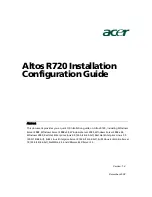Summary of Contents for S8A2
Page 2: ......
Page 3: ...PCIe to Serial ATA II Disk Array System easyRAID S8A2 Software Manual ...
Page 4: ......
Page 8: ...RAIDGuard X User s Manual 4 Introduction ...
Page 13: ...9 Software Installation ...
Page 18: ...RAIDGuard X User s Manual 14 Basic RAID Configuration ...
Page 34: ...RAIDGuard X User s Manual 30 Advanced RAID Configuration ...
Page 40: ...RAIDGuard X User s Manual 36 Step 3 Check the Confirm box and then the OK ...
Page 49: ...45 Appendices ...



































